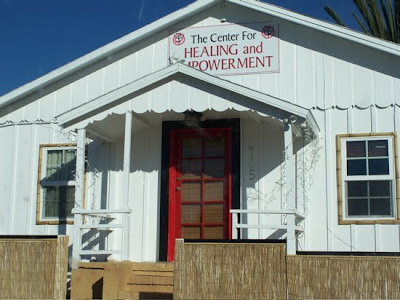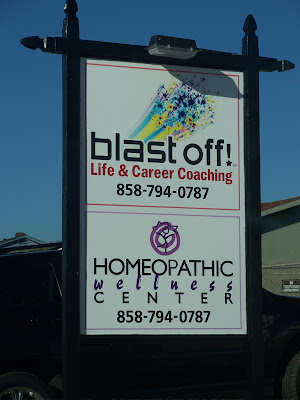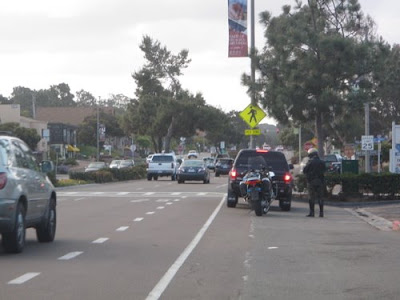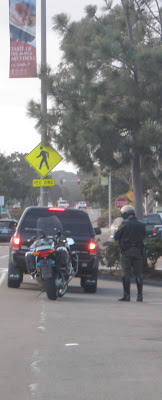 See our very own Leucadia local, Rheanna, playing at When in Rome tomorrow night from 7-10pm.
See our very own Leucadia local, Rheanna, playing at When in Rome tomorrow night from 7-10pm.
Thursday, April 30, 2009
Wednesday, April 29, 2009
Pile 'o Gravel

Location: Just north of Leucadia Blvd on Hwy101.
First item: Some resourceful commuter used a bike chain to lock a plastic chair to the bus stop sign.
Second item: Remember when everyone in Cardiff was pissed that giant mulch piles were showing up on San Elijo Ave? Well, you guys were lucky because in Leucadia we get big piles of gravel. ooooooOOOOOh! Pretty!
Tuesday, April 28, 2009
New Leucadia Art Gallery Opens May 2nd!

ERIC PHLEGER GALLERY
828 North Coast Hwy 101 (in the building with the Coast News)
Eric Phleger Gallery is proud to announce “In a Different Light,” an exhibition of paintings on view at the gallery from May 2 through June 6, 2009. An artists’ reception will be held Saturday, May 2, 2009 from 6-8 pm.
Sunday, April 26, 2009
Leucadia Gets Budgeted
La Costa Ave widening gets money, but only $375,000 three years from now and then no construction money in the following 3 years. That's interesting that they plan on designing and not building.
(click to blow up)
 The streetscape funding gets to $2.3million for construction next year and then a half million gets added each year thereafter for a long time.
The streetscape funding gets to $2.3million for construction next year and then a half million gets added each year thereafter for a long time.Can you build much for $2 million or even $3 million? The council is always talking about economies of scale and how it is a good idea to do one big project instead of piece meal, so if we could do something for $2 million would it be a good idea? Shouldn't there be more money?
How much is it going to cost to do the southern leg of the project?
Okay, the city budget has money trickling into the L101 project for over 6 years. Is this a sign that the city's budget doesn't have the steam to make the 101 "tree-ready"? Why the slow trickle?
Remember this quote from city council member and former Encinitas mayor, Dan Dalager describing the current state of the city budget, "We have a glass that is full and overflowing." If it is overflowing howcome the Downtown Encinitas streetscape is in deep freeze and the L101 streetscape won't be done for who knows how many years?
 Anybody know about this one? The way I read this, it looks like the city is going to close off the Leucadia Blvd rail crossing. That is interesting.
Anybody know about this one? The way I read this, it looks like the city is going to close off the Leucadia Blvd rail crossing. That is interesting. I have to admit I was surprised to see funding for the Hygia roundabout. They have funding for that project 4 years out and they are budgeting $2 million dollars. That is a lot of money especially when you consider how much is budgeted for the L101 streetscape.
I have to admit I was surprised to see funding for the Hygia roundabout. They have funding for that project 4 years out and they are budgeting $2 million dollars. That is a lot of money especially when you consider how much is budgeted for the L101 streetscape.If they close the RR crossing does that sink the justification for another roundabout?

The draft budget document doesn't have a few things:
1) It doesn't include unfunded projects. We can't see what the alternatives are and what they might cost.
2) I didn't see funding for Leucadia drainage issues. There are a lot of drainage issues across Leucadia.
You can follow these links to the budget documents.
Saturday, April 25, 2009
Rural Leucadia, does it still exist?
 Horsies at Ecke Ranch.
Horsies at Ecke Ranch. When I was a little kid growing up in Leucadia in the 1970's it was a common sight to see people riding horses around town. I wish we still had pretty girls with long blond hair riding horses down Leucadia Blvd to the beach. Where did they go? Is it even legal to ride a horse down the coast highway anymore?
Friday, April 24, 2009
Travel Review of Leucadia
Leucadia is an artsy beachside community within the picturesque South California beach community of Encinitas. At one time it was a mecca for surfers and hippies alike; remnants of the 1960’s era are still very much in evidence. Where else can you see tie-dye T-shirts, eclectic lawn art, cigar store Indians, hippie love beads and surfboard mailboxes?
You won’t find a Home Depot, McDonald’s or shopping mall in Leucadia, but you will still find some of the flower farms that made it the Poinsettia capitol of the world.
Leucadia is home to phenomenal restaurants, goofy shops, palm readers, coffee shops and hip galleries. Popular hangouts include Pannikin Coffee, housed in a former train station (very artsy); the iconic Lou’s Records (national recording artists have played in Lou’s parking lot) with an enormous collection of CDs and records; and Juanita’s Taco Shop, home of the best Breakfast Burritos on earth.
Leucadia’s residents say that the best thing that ever happened to Leucadia was that nothing ever happened to it. Leucadia’s beaches are lost in the 1960s and are old neighborhood surf breaks where hundreds of Leucadian’s have been surfing for thirty or more years.
You can find the complete article on yourtravelguide.com.
We should definitely fix up Leucadia and we should be thoughtful in our efforts to maintain the essence of Leucadia. When making zoning, infrastructure changes, or spending taxpayer dollars we should always think of the long-term consequences.What do we want Leucadia to be like in 15 years?
Thursday, April 23, 2009
Coast News Breaks Jru Update
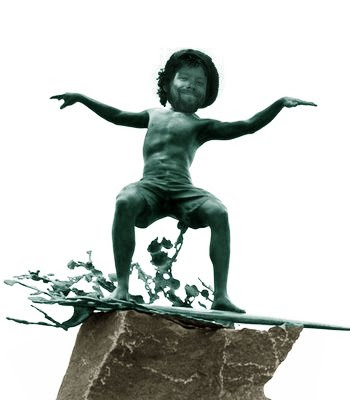
From The Coast News:
Andrew Watkins, a man who earned a reputation for his tree protest at Orpheus Park in Leucadia, was recently...
clickly clicky to find out.
It is good to support our local news outlets by visiting their websites and checking out what their advertisers have to offer.
Encinitas Street Fair this Weekend


The iconic Encinitas Streetfair is this weekend. A stunning 100,000 visitors are expected. I've loved the Streetfair ever since I was a kid even though it's not as rootsy as it used to be. Ignore the traveling corpo vendors and seek out the local artisans this weekend like my photographer friend Maggie Marsek who will be selling fine prints at her booth.
North Coast Current.com has a write on the musical lineup, Diversity marks Street Fair music scene
*I wish the city of Encinitas would let Leucadia use the coast highway for it's Art Walk event. Isn't closing down the entire downtown Encinitas 101 highway the ultimate "choke point"? Yet we always seem to be able to survive the weekend. *sigh*
**note-Dody Tucker from DEMA is looking for volunteers to help with the Big Grill 1pm – 5pm on Saturday. So if you have mad bar-b-que skills contact her at 760-943-1950
Wednesday, April 22, 2009
Leucadia: Still Funky
Tuesday, April 21, 2009
Monday, April 20, 2009
Coast Dispatch Returns in Online Form
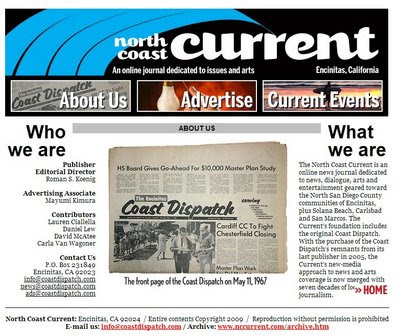
The fabled Coast Dispatch newspaper has been reborn as North Coast Current.
www.nccurrent.com
Here is a nccurrent.com story about Leucadian Scott Chatfield who fought and won the battle to keep our 760 area code, clicky click.
Mid-Morning Leucadia 101 Tree Canopy

I took this photo this morning around 8:45 am while taking my 19 month old son for a stroll. The temp was already into the 70's and the tree shade was pleasant and refreshing, demonstrating the importance of a healthy tree canopy for Leucadia's 101 merchant corridor. My iPhone camera didn't quite capture it, but the blooming wild flowers in the center median looked really pretty. This location is in front of Le Papagayo restaurant.
Saturday, April 18, 2009
Parks and Recreation
Parks and Recreation is a clever new tv show about small town government. The above Pilot episode is promising and there is sure to be plenty of comic fodder ahead that observers of the city of Encinitas can relate too.
Thursday, April 16, 2009
A Good Idea: Community Garden
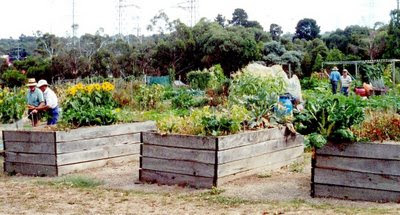
NCtimes.com: ENCINITAS: Council supports community garden concept
www.communitygarden.org
This link has a list of community gardens in San Diego county, click me.
Wednesday, April 15, 2009
The Del Mar Solution
Tuesday, April 14, 2009
San Diego Reader on Leucadia Streetscape
excerpt,
Some believe the project has gone too far beyond simply beautifying the surrounding area with landscaping, benches, sidewalks, and lighting; others believe the plan should include traffic calming and additional parking, making businesses more accessible to the public.
To get things rolling again -- after a year of listening to the public and devising a plan -- at Wednesday’s council meeting, city staff recommended an additional public workshop and an additional traffic study by MW Peltz. The cost: nearly $86,000.
“You’ve got the whole community upset. You should just stop the whole project now,” said one Leucadia resident during the public comment portion of the meeting.
Another Leucadian, a retired firefighter, told the council the five roundabouts and reduced lane size would be an emergency-response worker’s nightmare and would put substantial delays in response time to area residents.
“I don’t understand where you guys are coming from,” said the resident.
While some residents opposed the project (mainly the roundabouts), others supported holding an additional workshop to see the project proceed. Some residents were chastised for using scare tactics to convince residents to oppose the project.
Teabagging
Visit msnbc.com for Breaking News, World News, and News about the Economy
Do you like teabagging?
Monday, April 13, 2009
Steve Aceti: Double Agent
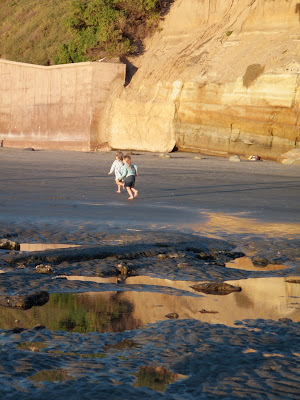
I found the following editorial in the Encinitas Historical Society's archives. It was published years ago by The Coast News. I wanted to link to it but I couldn't find it in their archives, so I typed it up.
It is written by Steve Aceti who runs the California Coastal Coalition (CalCoast). Now that it is clear that Aceti represents bluff-top property owners (like the Gordons on Neptune). I look at his editorial less as conciliatory and more as manipulative.

Last week, the LA Times ran a front-page article condemning seawalls and the "wealthy home owners" who request them. The article trotted out a simplistic, not to mention false, idea that residential seawalls are causing our beaches to disappear.
Coastal homeowners are an easy target, but the fact is that much more damaging things have been done in the coastal zone which have led to the disappearance of beaches up and down the coast. Have you driven Highway 101 or PCH lately?
They are two of the biggest dams in the State in terms of keeping sand from the beaches the parallel. And they are not part of the problem that the state and federal projects have created. This is not just a private landowners issue, although that's the way the die has been cast.
[Blogger's Note: The sand researchers I've spoken too say it is a suburban myth that San Elijo and Batiquitos would be productive sand sources if the train and roads were removed. Those estuaries were/are sediment traps not sources. The data has been available longer than I think Steve has been in California.]
No one likes seawalls, but the issue is more complicated than it looks. Residential seawalls are more obvious than some of the other culprits in the case of the disappearing shoreline so they take the most heat. But you could remove all the homes from the coast and you still wouldn't have nice, sandy beaches.
[If attracting tourists to come to our beaches is Steve's goal he needs to be careful because even nice seawalls detract from the sense of place that brings people to visit Encinitas. Natural beauty, not concrete jungle, is a tourist-oriented asset.]
 From a distance the Solana Beach seawalls
From a distance the Solana Beach seawallsblend in and are better than the ones
in Leucadia, aesthetically. When closer tourists
still know they aren't natural.
Coastal highways, inland dams, concrete riverbeds, harbor jetties and the like are prevent millions of cubic yards of sand from getting to the beach. The amount of sand held back from a residential seawall is microscopic in comparison. In face of a severely eroding shore-line, property owners are seeking permits for seawalls and other structures.
[We would still have bluff erosion and cobblestones in some years if we returned the coast to its wild state. When sand levels are low bluff generated sediment grows increasingly important, even if small fraction of the total sand budget. I'm not advocating planned retreat, just pointing out that Aceti likes to play both sides.]

The opponents of seawalls prefer a strategy known as "planned retreat" allowing the shore and bluff to erode without intervention. For many activists, however, that also includes good intervention, such as sand nourishment. Planned retreat is one of many planning tools that should be used along the coast where it is appropriate. Some homes and public facilities are in the wrong place and they should be moved or removed. But, the ocean is a dynamic environment and a one-size-fits-all approach to at he challenges along the coast will not work.
The face-off between proponents of planned retreat and homeowners incites an expensive ware of the experts in a never-ending debate over the merits of shore protection devices. There are no winners in the fight and the current debate (like the Times article) avoids the real issue: how to rebuild the shoreline so that seawalls, revetments and the like are unnecessary.
[Maybe we decide to do that, but we should not be fooled into thinking we are "restoring nature's patterns", because what is being advocated is barracaiding the coast with sand levels beyond the wild condition and making the taxpayer pay for it.]
The answer is easy. Put sand on the beaches and maintain them, both by restoring the natural flow of sediment to the shore (to the extent possible) and through artificial means (see Santa Monica, Coronado, Mission Beach, Newport Beach, Huntington Beach). Wide, sandy beaches will go a long way toward solving the problem, which makes it surprising that many of the groups that oppose seawalls don't support beach nourishment legislation.
[Aceti acknowledges that those wide beaches are man-made and that they are a solution to his real problem. Sometimes he spins the issue as a lack of sand for tourists but his solutions are optimized for bluff-top property owners' and not the taxpayer, and definately not the most common user of the beach–surfers.]

It is difficult to implement a strategy of planned retreat in the urban setting which prevails along most to the shoreline in the central and other regions of California. It would be great to allow the shoreline to just take its course, except that one major piece of the equation has been missing: an ongoing source of sediment to replace the sand that has washed out to sea or in the ocean canyons.
[Wouldn't bluff retreat help increase the sand that tourists could sit on? Here is a quote about some recent research, "[The] results call into question the conventional wisdom that coastal bluffs don't contribute much to the beaches," said Scott Ashford, a professor of structural engineering at UCSD.]
Before the construction of federal marine navigation projects, dams, highways, mall and parking lots, there was an adequate supply of sand reaching the shore through natural means.
[Coastal bluff erosion has been happening for millions of years and is part of the wild system. We even have pictures of it happening early in this century. Aceti is advocating that man-made projects block a source of our beach's sand. Why the inconsistency? Don't get me wrong. I don't subscribe to the "return our ecosystems to the wild condition" ideology, because we can't and because we don't optimize the use of our natural resources that way. It is just that something about CalCoast doesn't add up. ]
Since this is no longer the case, allowing the shoreline to erode at will is like jumping out of a plane without a parachute.
[I think he means it is like building a house in a floodplain.]
We can't expect beaches to fight this fight without some ammo. Another issue: what do we do with all the public infrastructure that has been built along the coast?
[Steve Aceti has a good point about the public infrastructure. We should be consistent with the way we look at private and public assets. Just for fun, I'll point out that the State Parks hasn't been armoring their Encinitas property with seawalls.]
Until we get off the adversarial "us versus them" merry-go-round, we will never have the types of solutions that our counterparts on the East Coast have to maintain their shorelines.
[I am sure that is easy for Aceti to say that since he represents two sides. Aceti clearly does not represent the dominant users of our beaches–surfers.]
Leucadia on Facebook

Jason Holloway has created a Leucadia page on the social networking site Facebook. You can become a fan of Leucadia, communicate with other Leucadians and upload photos and post events, thoughts and news. I've started one photo gallery already and will contribute mores stuff soon. It's pretty cool, check it out click here.
You have to become a member of the Facebook community to join. Facebook is free and easy to use. Warning! It's addictive.
Sunday, April 12, 2009
PreSand Diversion Bluff Erosion
Here is a historic photo from Solana Beach. It was taken long before the harbor opened.
 Notice the seaweed up to the bluff's toe (the high tide line?) and the two caves carved out by erosion.
Notice the seaweed up to the bluff's toe (the high tide line?) and the two caves carved out by erosion.See Also: Historic Encinitas Beaches and Bluffs
Saturday, April 11, 2009
Botanical Gems of Leucadia: Part III


One fruit tree that we are well suited to grow is the loquat. The loquat doesn't like to be exposed to extremes, so we are just right. You'll even find loquats growing as volunteers all over Leucadia. You'll see them now that I pointed this out. Many of our yards are comfortably wild.
Loquats are relatively drought tolerant. They won't produce as much fruit without some supplemental watering but they can handle the tap getting turned back. They will hang out and wait for the good times to return.
Loquats aren't a good commercial fruit. They have a few big seeds in the middle, but you can still eat them out of hand no problem. There are white fleshed and orange/yellow fleshed varieties. I've had a few unnamed orange varieties (from Leucadia) that taste like they are a candied fruit. The whites that I've had from around here tend to have deeper and juicer flesh. The shelf life of loquat is super short so you got to eat it right away. This precludes this fruit from sitting on a grocer's shelf. They also seem to bruise easily, so they don't transport well.
All the more, that makes the loquat another special part of living in Leucadia.
For more on loquat: Fruit Facts.
(If you have a good loquat, please let me know if I can have a few branches to graft onto my trees.)
Thursday, April 09, 2009
"There is hope."

NCtimes.com ENCINITAS: Council agrees to additional planning for streetscape project
In a unanimous vote, the council agreed to spend up to $85,900 for additional traffic studies, a fourth public workshop and some mailers or other publicity on the issue.
Wednesday, April 08, 2009
Important City Council Meeting April 8th
Three presentations/proclamations:
DMV/Donate Life California Month
Presentation of San Diego Excellence in Energy Award to the City for it's solar roof project
April Earth Month in the City of Encinitas
Five items on the Consent Calendar
Two Items on the Regular Agenda:
*Public Hearing on appeal filed by the city concerning a condition of the Planning Commission's decision concerning pedestrian railroad under-crossings.
***Status update and discussion of the North Coast Hwy 101 Streetscape project
view agenda online
Tuesday, April 07, 2009
The Bird Rock Solution
 Before my trip south, I stopped at an Encinitas restaurant for breakfast. There was sidewalk dining and lots of people walking. No nearby roundabouts. Just traffic signals and four lanes of traffic.
Before my trip south, I stopped at an Encinitas restaurant for breakfast. There was sidewalk dining and lots of people walking. No nearby roundabouts. Just traffic signals and four lanes of traffic. People in Bird Rock love their little coastal urban village.
People in Bird Rock love their little coastal urban village. Except for the street sign overkill, Bird Rock was nicely landscaped and inviting. Palm lined streets have been iconic of So Cal and I expect the Bird Rock landscaping style and urban elements will become just as symbolic of So Cal. Bird Rock is the future.
Except for the street sign overkill, Bird Rock was nicely landscaped and inviting. Palm lined streets have been iconic of So Cal and I expect the Bird Rock landscaping style and urban elements will become just as symbolic of So Cal. Bird Rock is the future.
From a UT article about Bird Rock:
What's being "modeled" are its five roundabout traffic circles which are generating interest from other communities.
From the same UT article:
"The key is really not just having people with the technical skills, but attracting people to come out. It is very important to get consensus on what the problems are first. Too often, there's a rush to get to solutions."
When the streetscape project started I was very excited that the 101 would be spruced up. I wasn't alone in thinking the scope would be sidewalks, benches, lights and landscaping. The solutions that have emerged go beyond that scope and we are dealing with parking, traffic, and sidewalk usages, I think. Forgive me if I missed it, but I still don't know if the problems/issues/scope was ever explicitly agreed upon.
It would be a good idea to do that early. For instance, if speeding cars or specific intersections are something to work on, we should be including the traffic commission now so we don't drag this process out.

From a La Jolla Light article:
Part of the reason for customers returning was the community had become more "walkable." "It's totally changed the vibe of La Jolla Boulevard," he said, "made it more convenient for people to actually use it."
La Jolla Bloulevard was walkable before the streetscape.
It has changed the vibe. A romantic view would be the that the Boulevard is more like a courtyard or a town square, except there isn't open space in the middle. There are still bursts of traffic, buses, and Harley motorcycles. It doesn't feel like a small town downtown main street. It is new urbanism.
The roundabouts probably kept the traffic from the acceleration-deceleration cycles that would occur with traffic signals, but we aren't talking about putting roundabouts in at every block like Bird Rock, are we? Bird Rock is only a few blocks long. I think people are thinking about a few roundabouts across all of Leucadia. I don't know if Bird Rock is a good overall comparison.
From an older La Jolla Light article:
Five roundabouts will replace stop signs along La Jolla Boulevard in the business district. Traffic will narrow to two lanes from four, and diagonal parking will be added on half the street. Concrete medians decorated with trees and flowers will run down the heart of the thoroughfare.
From a UT Article:
Some worry that the roundabouts will push drivers onto residential side streets to avoid the boulevard, despite the installation of smaller traffic circles there to discourage that behavior.
"Five roundabouts – one on every intersection – has to be overkill by any standard," said David Little, who thinks drivers will try his nearby street as a through route. "This plan sacrifices residential streets for the sake of businesses and condominiums on La Jolla Blvd." ...
"There's just a different feeling in the air," said Filter, a resident of La Jolla. "The community is really embracing it. They want it to be a retail district."
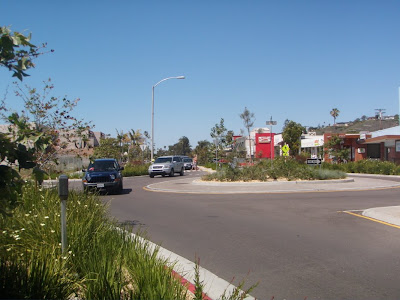 The Bird Rock roundabouts weren't that interesting. I am hoping that Leucadia's roundabouts are unique in some way. I am definitely in favor of community created/sponsored art in the center of ours. Something that doesn't facilitate turning Leucadia into Anytown, California.
The Bird Rock roundabouts weren't that interesting. I am hoping that Leucadia's roundabouts are unique in some way. I am definitely in favor of community created/sponsored art in the center of ours. Something that doesn't facilitate turning Leucadia into Anytown, California.I tried to talk to a few folks from that zone about the infrastructure changes. I spoke first with Don Schmidt. Don lives within walking distance of the roundabout zone.
 Don told me the community is still divided on the application of roundabouts in Bird Rock. He noted that the roundabouts cost ~$5 million and that timed lights would have cost far less. Don made the point, "This is slowing traffic down, but [retailers] want to capture the traffic."
Don told me the community is still divided on the application of roundabouts in Bird Rock. He noted that the roundabouts cost ~$5 million and that timed lights would have cost far less. Don made the point, "This is slowing traffic down, but [retailers] want to capture the traffic."Don surprised me when he told me about how the upkeep of the street is being funded. The community is taxed to maintain the new street landscaping. A maintenance assessment district was set up where residents of Bird Rock will pay $60 to $90 a year; merchants will pay an average of $500.
Don also noted that he was skeptical of the sales pitches that surround the "walkability" movement. (It is worth noting that Don walked from his home to the coffee shop where I met him.)
It seemed that Don supported the assessment district, but he did see the assessment as a kind of subsidy of the merchants and their property owners. If the goal was to convert the publicly owned thoroughfare into a bazaar-like destination, I can see his point. It made me wonder how the City of Encinitas is going to pay for the streetscape. The City loves to say they don't have enough money to fund our current landscaping.
Don couldn't say if there had been traffic diverted to other streets. He noted that it would be good to look at the traffic data for La Jolla Mesa, Solidad Mt. Road, Van Nuys and some of the other PB back streets. It seems to me that evaluating the impact requires looking at that sort of data.
It is my opinion that we should encourage long distance commuters to use the freeway. It is also my opinion that we should not do things that encourage locals to avoid using our city's arteries. For better or worse, the 101 is an artery. It is not currently a country lane or a side street. If we want to rededicate its use we should start by establishing this position.
I don't know if what is proposed is going make a real change in usage, but we shouldn't pretend that there is no chance of permanent negative consequences. I propose that we do field tests before committing millions of dollars on a particular approach.
I also spoke with Peter Morris, owner of Smashing Designs in La Jolla. Peter lives in P.B. and commutes into La Jolla. He says that about 25% of the time he will commute via La Jolla Boulevard. He humbly admits that when he first heard about the roundabouts he thought it was "the stupidest idea." He adds, "My foot is now in my mouth."
The traffic moves way better than he thought it would and he says he never comes to a complete stop though Bird Rock.
The Bird Rock project hasn't changed his driving habits and he doesn't know about others purposely avoiding Bird Rock because of the project (or that people were using it more). However, he was already going around Bird Rock most of the time.
 I found it really interesting that one block over was the street locals biked and walked. It was a residential street, not mixed use.
I found it really interesting that one block over was the street locals biked and walked. It was a residential street, not mixed use. Closing Note: On the way home I wanted to stop for lunch at Wahoo's. That's in La Jolla. I didn't really care if there is no streetscape improvements or roundabouts there, but I did care that there was no available parking. I couldn't find a place to park so I bailed and ate at home.
Closing Note: On the way home I wanted to stop for lunch at Wahoo's. That's in La Jolla. I didn't really care if there is no streetscape improvements or roundabouts there, but I did care that there was no available parking. I couldn't find a place to park so I bailed and ate at home.
Monday, April 06, 2009
Sunday, April 05, 2009
Kidnappers Come to Leucadia
"In Leucadia, the man reportedly saw his brother in the back of a grey car with Arizona plates, but the [possible] kidnappers punched him in the face and drove off instead of freeing his brother."
Saturday, April 04, 2009
inconceivable!

2:00 a.m. April 4, 2009
SAN MARCOS: Construction of a pedestrian rail crossing at Marcos Street and Mission Road in the Richmar neighborhood could start soon, but a date hasn't been set.
The crossing will allow pedestrians to reach Autumn Drive on the south side and Mission Road on the north side. The crossing will have warning bells, lights and small crossing gates.

